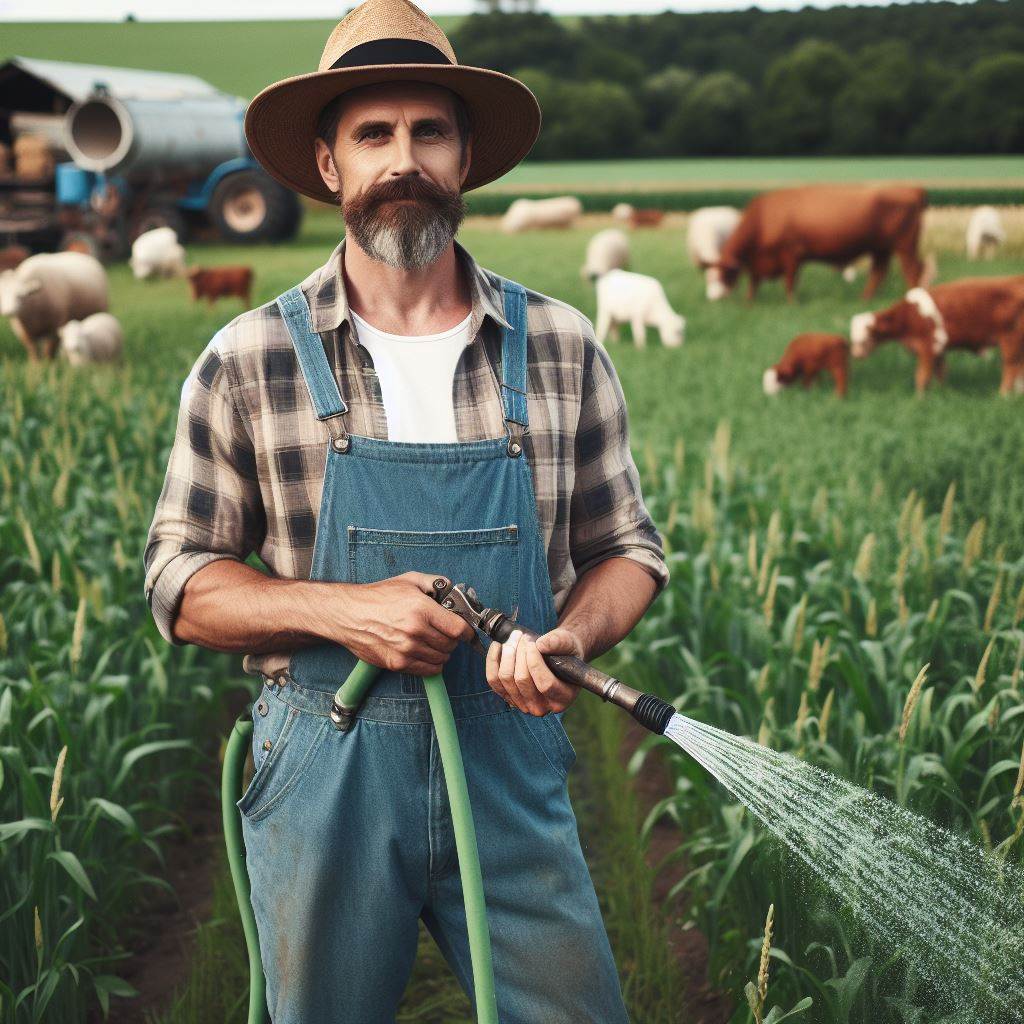Introduction
Sustainability plays a crucial role in farming, ensuring the long-term viability of agricultural practices.
Rainwater harvesting is an effective and sustainable approach towards water conservation.
This section aims to provide an overview of rainwater harvesting and explore its significance for farmers.
Sustainability in farming involves environmentally-friendly practices that promote soil health, water conservation, and minimize negative impacts on ecosystems.
It ensures the production of safe and healthy food while preserving natural resources for future generations.
Rainwater harvesting involves collecting and storing rainwater for various agricultural purposes.
This method conserves water, reduces dependency on external water sources, and minimizes soil erosion and runoff. It is a sustainable solution to address water scarcity and improve the overall farming system.
Rainwater harvesting holds great value for farmers, especially in areas with limited water resources.
By capturing rainwater, farmers can supplement irrigation needs, improve crop yield, and reduce reliance on costly water supplies.
Additionally, rainwater is free from impurities and chemicals, promoting healthier plant growth.
Moreover, this practice reduces the strain on existing water infrastructure and contributes to the resilience of the farming community.
In short, rainwater harvesting offers an excellent sustainable solution for farmers to mitigate water scarcity and adapt to changing climate conditions.
By implementing this practice, farmers can ensure the long-term sustainability of their operations while conserving precious water resources for future generations.
Benefits of Rainwater Harvesting
Reduction in water costs
Rainwater harvesting helps farmers reduce their reliance on expensive municipal water supplies.
By collecting rainwater, farmers can lower their overall water consumption and save money on utility bills.
Transform Your Agribusiness
Unlock your farm's potential with expert advice tailored to your needs. Get actionable steps that drive real results.
Get StartedPreservation of groundwater resources
Rainwater harvesting reduces the demand for groundwater sources, preserving them for future use.
It helps in maintaining a sustainable balance between water extraction and groundwater replenishment.
Mitigation of soil erosion
Harvesting rainwater prevents excessive runoff, reducing soil erosion and associated nutrient loss.
It helps to maintain soil structure, fertility, and long-term agricultural productivity.
Enhancing plant growth and maximizing yields
Rainwater is free of salts, chemicals, and pollutants, providing healthier water for plants.
Adequate water supply through rainwater harvesting promotes robust plant growth and higher crop yields.
Contributing to climate change resilience
Rainwater harvesting enables farmers to adapt to changing weather patterns and extreme climatic conditions.
With a stored water source, farmers can withstand droughts, ensuring the continuity of their agricultural activities.
Rainwater harvesting offers numerous benefits to farmers, promoting sustainable agriculture and enhancing their overall economic stability.
By reducing water costs, farmers can allocate their resources to other farming needs and investments.
Preserving groundwater resources ensures their availability for future generations and helps maintain ecological balance.
Mitigating soil erosion through rainwater harvesting protects farmland and improves soil quality, leading to sustainable agricultural practices.
Enhanced plant growth and increased crop yields are results of reliable water supply, as rainwater is pure and beneficial for plant health.
By contributing to climate change resilience, rainwater harvesting enables farmers to adapt to adverse weather conditions and protect their livelihoods.
In fact, rainwater harvesting plays a vital role in ensuring agricultural sustainability. Farmers embrace this practice to reduce costs, preserve groundwater, mitigate soil erosion, enhance plant growth, and build climate resilience.
Read: Smart Drip Irrigation: Boosting Farm Water Efficiency
Preparing for Rainwater Harvesting
Assessing water needs and usage
Proper preparation is crucial for successful rainwater harvesting.
Before implementing this sustainable water management practice, farmers need to assess their water needs and usage.
By determining the amount of water required for both farming activities and domestic use, farmers can make informed decisions regarding rainwater storage and distribution infrastructure.
Identifying suitable infrastructure and equipment
To identify suitable infrastructure and equipment, farmers should consider various components.
Rainwater collection systems, such as tanks and barrels, are key for effectively storing the harvested water.
Additionally, it is important to install gutters, downspouts, and filters to ensure rainwater is efficiently directed into the collection systems.
Investing in pumps and distribution systems can further enhance the effectiveness of water supply throughout the farm.
Calculating rainfall capture potential
Calculating the rainfall capture potential is another crucial step in preparing for rainwater harvesting.
Showcase Your Farming Business
Publish your professional farming services profile on our blog for a one-time fee of $200 and reach a dedicated audience of farmers and agribusiness owners.
Publish Your ProfileBy understanding the average annual rainfall in their region, farmers can estimate the amount of water that can be harvested.
This can be achieved through the use of rain gauges or by consulting local meteorological data to identify rainfall patterns.
Planning for storage and distribution infrastructure
Lastly, farmers must carefully plan the storage and distribution infrastructure for their harvested rainwater.
It is vital to design a storage system that can accommodate the anticipated amount of harvested water.
Determining the appropriate location and size of distribution infrastructure is equally important to ensure a proper water supply to the farm.
In essence, by assessing water needs and usage, identifying suitable infrastructure and equipment, calculating rainfall capture potential, and planning for storage and distribution infrastructure, farmers can effectively prepare themselves for rainwater harvesting.
This proactive approach sets the foundation for a successful and sustainable water management system, benefiting both the farm and the environment.
Read: Organic vs Conventional: A Deep Dive Analysis
Implementing Rainwater Harvesting
Implementing rainwater harvesting on a farm requires careful planning and consideration of various factors.
This section discusses the necessary steps involved in successfully implementing a rainwater collection system for sustainable farming practices.
Designing the rainwater collection system
Sizing the system based on water requirements
The first step in designing a rainwater collection system is determining the size of the system based on the farm’s water requirements.
This involves calculating the amount of water needed for irrigation, livestock, and other essential farm activities.
Placement and positioning of collection elements
Next, it is crucial to carefully choose the locations for rainwater collection elements, such as gutters, downspouts, and storage tanks.
Proper placement and positioning maximize water collection efficiency and minimize potential obstructions or contamination risks.
Ensuring accessibility and maintenance of equipment
The rainwater collection system should be designed to facilitate easy access for maintenance and repairs.
Regular maintenance is vital to ensure the longevity and proper functioning of the equipment, including cleaning gutters, inspecting storage tanks, and repairing any damage.
Installation of infrastructure and equipment
Once the rainwater collection system is designed, the next step is its installation.
This involves setting up the necessary infrastructure, including connecting gutters to downspouts and directing water flow towards storage tanks.
Integrating rainwater harvesting with existing irrigation systems
In order to optimize its benefits, rainwater harvesting should be integrated with existing irrigation systems.
This can be achieved by connecting the stored rainwater to irrigation pipelines or utilizing pumps to distribute water to fields or crops.
Incorporating sustainable practices in farm management
Crop selection and rotation
Choosing appropriate crops is essential for sustainable farm management.
Some crops are better suited for rainwater irrigation, while others may require alternative sources.
Additionally, implementing crop rotation practices helps maintain soil fertility and reduces water demands.
Soil conservation techniques
Incorporating soil conservation techniques, such as contour plowing, terracing, and cover cropping, helps minimize soil erosion and improve water retention.
These practices contribute to the overall efficiency of rainwater harvesting and promote long-term sustainability in farming.
By following these steps and integrating rainwater harvesting with existing farming practices, farmers can significantly reduce their reliance on external water sources and contribute to a more sustainable and environmentally friendly agricultural system.
Read: Organic Farming Trends: What’s Next?

Maintenance and Challenges
Regular inspection and cleaning of collection components
Regularly inspect and clean all components of your rainwater harvesting system to ensure efficient water collection.
Addressing potential issues with water quality
Implement measures such as filtration and disinfection systems to address any potential issues with the quality of harvested rainwater.
Monitoring and managing water levels and distribution
Regularly monitor water levels in storage tanks and ensure proper distribution to different areas of your farm.
Mitigating risks associated with extreme weather events
Develop a contingency plan to mitigate risks such as flooding or drought, which can impact the effectiveness of rainwater harvesting.
Overcoming challenges specific to local farming practices and regulations
Be aware of and comply with local farming practices and regulations that may pose challenges to rainwater harvesting, and find creative solutions to overcome them.
Read: Pollinators: Heroes of Organic Farming
Case Studies: Successful Rainwater Harvesting Practices
Example 1: Rajendra Singh’s experience with rainwater harvesting
Rajendra Singh, a farmer from India, implemented rainwater harvesting techniques on his land.
He observed numerous benefits from this practice, including increased crop yields and improved groundwater levels.
Singh found that utilizing rainwater reduced his dependence on expensive irrigation methods.
By collecting and storing rainwater, he was able to sustain his farming activities even during dry spells.
The availability of water allowed him to grow a wider variety of crops throughout the year.
Singh also noticed that rainwater harvesting helped mitigate the impact of droughts on his farm.
This success story inspired other farmers in the region to adopt similar practices.
Showcase Your Farming Business
Publish your professional farming services profile on our blog for a one-time fee of $200 and reach a dedicated audience of farmers and agribusiness owners.
Publish Your ProfileThrough his experience, Singh learned the importance of proper planning and maintenance for rainwater harvesting systems.
He emphasized the need for regular cleaning of storage tanks and the implementation of effective filtration methods.
Singh encourages farmers to assess their specific needs and consider the feasibility of rainwater harvesting in their own contexts.
Example 2: Tony Rinaudo’s innovative rainwater collection method
Tony Rinaudo, an environmentalist, developed a unique approach to rainwater collection in Africa.
His method involved collecting water by directing it towards the roots of trees using contour trenches.
Rinaudo discovered that this technique not only conserved water but also helped in reforesting degraded areas.
The trenches allowed the water to seep into the ground, replenishing the soil and improving its fertility.
By strategically implementing this method, Rinaudo was able to transform barren landscapes into productive farmlands.
This approach proved highly replicable in other farming contexts, especially in regions prone to water scarcity.
The technique also combated desertification, preventing further degradation of the land.
Rinaudo’s innovation gained recognition globally and has been adopted in various countries.
The successful outcomes of this rainwater collection method have restored hope for farmers facing water shortages.
Rinaudo urges farmers to embrace sustainable practices like rainwater harvesting to ensure the long-term viability of their farms.
By examining the experiences of Rajendra Singh and Tony Rinaudo, it is evident that rainwater harvesting can bring about significant benefits for farmers.
Their success stories serve as inspiration and provide valuable insights and lessons for others embarking on similar journeys.
Through proper planning, maintenance, and innovation, rainwater harvesters can reduce reliance on expensive irrigation methods, improve crop yields, mitigate the impact of droughts, and contribute to environmental conservation.
These case studies demonstrate the replicability and adaptability of rainwater harvesting practices in various farming contexts, highlighting its potential as a sustainable solution for water scarcity in agriculture.
Conclusion
Rainwater harvesting is a vital practice that farmers should prioritize.
By collecting and storing rainwater, farmers can ensure a reliable water source for their crops, even during droughts.
This sustainable practice not only reduces dependence on groundwater and surface water sources, but also helps to minimize erosion and runoff, improving overall soil health.
Furthermore, by implementing rainwater harvesting systems, farmers can save on irrigation costs and reduce their impact on the environment.
This method promotes efficiency and responsible water use.
It is essential for farmers to adopt sustainable practices like rainwater harvesting to ensure the long-term viability of their farms and contribute to overall agricultural sustainability.
By embracing such techniques, farmers can minimize the strain on water resources and protect the environment.
Finally, rainwater harvesting holds tremendous potential in achieving agricultural sustainability.
With proper planning and implementation, it can significantly contribute to water conservation efforts and reduce the impact of farming on ecosystems.
By raising awareness and encouraging more farmers to adopt rainwater harvesting, we can enhance the resilience of our agricultural systems and foster a more sustainable future for generations to come.




